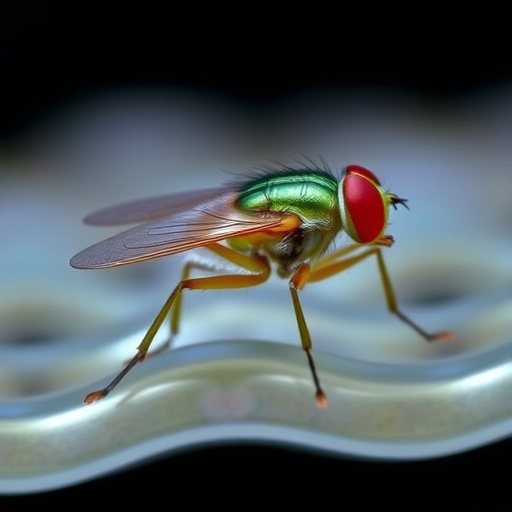In a groundbreaking endeavor to unravel the genetic complexities underpinning Alzheimer’s disease, scientists from Baylor College of Medicine and the Jan and Dan Duncan Neurological Research Institute at Texas Children’s Hospital have taken a distinctive approach. By leveraging the genetics of the fruit fly, Drosophila melanogaster, these researchers have illuminated the roles of 100 human Alzheimer’s risk genes in brain health, function, and aging. This innovative study, recently published in the American Journal of Human Genetics, offers unprecedented insight into how these genes influence neuronal integrity and disease pathways, potentially paving the way for more targeted therapeutic strategies.
Alzheimer’s disease is marked by progressive neurodegeneration resulting in cognitive decline and memory loss. Although genome-wide association studies have identified hundreds of genes associated with increased risk, the precise biological mechanisms remain elusive. This knowledge gap hinders the development of effective treatments. To overcome this barrier, the researchers utilized the fruit fly, whose genome surprisingly harbors homologs to a majority of human genes. The fly’s relatively simple nervous system and rapid life cycle provide an ideal model to dissect gene function in a living organism over a compressed timeline, directly linking genetic variations to neurological outcomes.
The research team, spearheaded by neuroscience graduate Dr. Jennifer Deger, employed gene knockout techniques to “turn off” individual risk genes in fruit flies. They systematically evaluated the impacts of these genetic disruptions on brain architecture, neuronal activity, and resilience to environmental stress as the flies aged. This approach allowed the team to gauge how the loss of each gene individually affected brain integrity, synaptic function, and the organism’s capacity to withstand stressors that mirror human neurodegenerative conditions.
One of the pivotal revelations was the discovery that most Alzheimer’s risk genes are actively expressed in the adult fly brain. Notably, subsets of these genes exhibited preferential expression in distinct brain cell types: 24 in neurons—cells responsible for transmitting electrical signals—and 13 in glia, the supportive and regulatory cells within the nervous system. This cell-type specificity illuminates how distinct genetic perturbations might differentially affect neural circuits and brain health, underscoring the intricate cellular interplay implicated in Alzheimer’s pathology.
Functionally, the researchers revealed 50 candidate genes that influence both physical brain structure and neurobiological function. Of these, 18 genes elicited clear signs of neurodegeneration when silenced, manifested as physical deterioration of brain tissue. A standout gene was Snx6, the fly homolog of human SNX32, whose disruption led to pronounced neuronal tissue degradation characterized by the development of necrotic holes. Such findings highlight critical genetic contributors to the structural breakdown seen in Alzheimer’s, advancing our understanding of disease mechanisms at the cellular and molecular scale.
In addition to structural degeneration, the study investigated how gene knockouts affected neuronal electrical activity and behavioral responses to stress. Thirty-five genes proved essential for maintaining normal neuronal electrophysiology, while eight were critical for the flies’ ability to recover from acute stressors such as elevated temperatures and mechanical shocks. Flies with disrupted genes in these categories displayed seizure-like activity or paralysis, paralleling neurological dysfunction and stress vulnerability observed in humans with Alzheimer’s or related dementias.
The investigation further delved into interactions between Alzheimer’s risk genes and toxic protein aggregates ubiquitous in the disease such as amyloid-beta and tau. Twenty-eight genes modulated the flies’ response to these proteins, either exacerbating or mitigating their detrimental effects. This modulation underscores genetic influences in proteinopathy pathways, suggesting that the genetic landscape not only predisposes individuals to disease but also determines the extent of neurotoxic damage from hallmark Alzheimer’s aggregates.
Intriguingly, the team identified distinct biological pathways underlying Alzheimer’s disease susceptibility by clustering genes based on the type of brain deficits they caused—whether structural damage, functional impairment, or diminished stress resilience. This gene grouping corresponded with genetic risk profiles observed in patient populations, revealing causal heterogeneity. Some individuals harbor genetic variants primarily affecting brain morphology, while others bear variants influencing stress response, painting Alzheimer’s as a multifaceted disease with diverse etiologies.
This heterogeneity might elucidate the clinical variability seen in Alzheimer’s patients, explaining why symptom progression and treatment responses differ significantly. Personalized medicine approaches could leverage this knowledge to stratify patients by genetic risk profiles and tailor interventions targeting specific pathological pathways, a transformative concept in neurodegenerative disease management.
To democratize access to their comprehensive data, the researchers launched ALICE (Alzheimer’s Locus Integrative Cross-species Explorer), an interactive web portal that integrates their functional findings with human genetic data. This platform enables scientists worldwide to explore gene-brain relationships, facilitating collaborative research and accelerating discovery of novel therapeutic targets. ALICE represents a vital resource bridging model organism genetics with human disease biology.
The study’s blend of genetic engineering, neurobiology, and systems neuroscience exemplifies the power of integrative experimental design. By dissecting each risk gene’s contribution within the context of an entire organism’s nervous system, the researchers deliver a level of mechanistic insight unattainable through human studies alone. Their findings establish a roadmap for future endeavors aimed at pinpointing molecular nodes amenable to therapeutic intervention.
Supported by a robust framework of NIH grants and philanthropic funding, this work stands at the forefront of Alzheimer’s research. It demonstrates how classical model systems like Drosophila can enlighten human health challenges, reaffirming the translational potential inherent in cross-species genetic analysis. As Alzheimer’s disease continues to impose a staggering societal toll, such innovative research offers renewed hope for unraveling its molecular mysteries and ultimately curbing its devastating impact.
By clarifying the nervous system requirements of Alzheimer’s risk genes, the study invites a paradigm shift—from viewing Alzheimer’s solely as a uniform disease to appreciating it as a constellation of genetically and biologically diverse conditions. This nuanced perspective will be crucial in crafting precision therapeutics and improving outcomes for millions affected by this relentless neurodegenerative disorder worldwide.
Subject of Research: Animals
Article Title: Revealing the nervous system requirements of Alzheimer’s disease risk genes in Drosophila
News Publication Date: 29-Oct-2025
Web References: https://alice.nrihub.org/
References: DOI 10.1016/j.ajhg.2025.10.003
Keywords: Alzheimer’s disease, genetics, neurodegeneration, Drosophila melanogaster, amyloid-beta, tau protein, neurobiology, stress resilience, neuronal function, causal heterogeneity, precision medicine, neurogenetics




